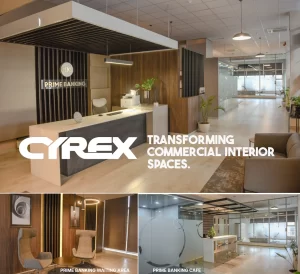In a world where first impressions matter, Cyrex has mastered the art of transforming bland spaces into captivating canvases that speak volumes about the businesses they represent. The company has established a reputation for high-quality work that visually enhances a space and gives it a sense of identity and ownership.
Structure and Design Magazine’s Perry Kaande (PK) recently caught up with Wisdom Gakaka (WG), co-founder and Managing Director of Cyrex Branding and Cyrex ID. An award-winning entrepreneur and dynamic speaker, Gakaka is not only shaping the business landscape but also actively mentoring aspiring entrepreneurs and professionals.
PK: How long has Cyrex Branding been in existence and when did it get into interior development?
WG: Cyrex Branding has been in existence since 2006 with a core focus on signage and branding material manufacturing. As the years have gone by this has incorporated design, printing, metal fabrication, 3D, installation, rigging and fabrication which allows us to undertake full campaign rollouts.
We ventured into interior development about 5 years ago focusing on corporate and commercial spaces, primarily customer facing areas that required a brand experience that went beyond logos and posters.
PK: What inspired the company to venture into interior development?
WG: With our vast exposure to interior spaces during our branding projects, we realized that we were often installing new and beautiful signage in old, dated spaces. It was more of putting lipstick on a pig. The work that we did was less impactful given the environment it was sitting in. We felt the need to give our clients the full overhaul that would give a refreshed brand experience.
PK: What are the key considerations for an interior developer when designing an interior space?
WG: Form, function and aesthetic. Spaces must work!
Our design process is interactive and requires contribution from the client. Considering that after all is said and done it is the client that is left with a space that answers their questions and addresses their needs. Our experience allows the client to benefit from our exposure to new trends and industry best practices.
PK: What is the company’s approach to interior design?
WG: Our approach is to merge branding and interior to give a brand experience. Our 17 year experience in branding has allowed us to be exposed to some the countries top brands as well as established international brands. We understand the need for brand representation, brand communication and brand experience at every touch point.
This merge allows us to choose materials that incorporate colours and textures that complement the clients’ corporate identity. We are able to integrate brand elements in the space to make it visually appealing with subtle brand references.
Combining branding with interior design from the onset rather than it being an afterthought allows for big savings for the client. Logos and brand elements are integrated into the counters, bulkheads, fabrics, paneling, partitions etc and this happens at the time of construction. This process helps the client save both time and their hard earned money.
PK: What is your approach to working with clients to ensure that their needs and expectations are met?
WG: This depends on the client and the project. Core Functionality, risk management and security are important aspects to ensure the clients input. The client knows the statutes and minimum requirements of their particular industry. Once those are out of the way, most clients will give a fair amount of creative freedom. This is where we flourish.
It is however important to build the relationship to the point that the client feels we know and understand their brand and their core objectives. This allows us to throw in a few pleasant surprises to enhance the experience.
PK: How do you collaborate with architects and other stakeholders to ensure a cohesive design?
WG: Collaboration with specialists is important because it is imperative to have a functional space in terms of services. Air-conditioning, security and networking electricals need to cohesively integrate with the general design.
We involve specialists from the design stage so that the space is not only aesthetically pleasing but also technically sound.
PK: Can you share an example of a recent project and the particular work that you did?
WG: CBZ Pomona was an exciting project for us. We were able to introduce “the open bank” to the market. This is a concept where services are front and centre, and clients are not greeted by security doors at the entrance. Instead, the branch is open, welcoming and highlights that the bank has so much more on offer than just processing cash.
The project had an excellent balance between client input and creative freedom on our end. It’s always refreshing to work a forward thinking client that is not only forward thinking but willing to implement ideas.
Together we were able to create a premium experience for clients at all levels, a true upgrade for every CBZ customer.
PK: What are your thoughts on the use of technology in interior design?
WG: Technology is a great addition as it allows you to simulate spaces. Augmented reality for example is an exciting way to allow a client to get a feel of the design and environment before implementation. Our team is researching on Ai integration into our work to see how it can improve our workflow and the experience for our clients.
PK: How do you stay up-to-date on the latest trends in interior development?
WG: Research and development is one of our competitive advantages. We invest heavily in it. Taking the time to travel and interact with experts in the field internationally. We not only interact with designers, but also experts in the areas of materials, furniture, lighting etc. There is constant innovation within the industry making materials more durable, cheaper and more aesthetically pleasing. Our exposure affords us the ability to create more unique spaces for our clients.
PK: What are some of the latest trends in interior design that you are incorporating into your projects?
WG: While the trends come and go we always lean towards the creation of timeless spaces that transcend “temporary hype”. We believe our clients invest in our abilities and in turn we ensure they get a more than fair return on investment by ensuring the lifespan of our work is of benefit to them. We ofcourse throw in small trendy touches but these are often less permanent features.
PK: What role does sustainability play in your design process?
WG: Many of our clients have wide branch networks, and it is therefore important for us to ensure the materials we use are sustainable and durable. There is a huge trend towards sustainability. We strive as much as possible to use recycled materials and incorporate green spaces within our desgns. Our supply chain is crucial and we keenly check on their sourcing and manufacturing policies. By combining sustainability and durability we reduce overall waste.
PK: How do you balance aesthetics with functionality in your designs?
WG: Functionality is the starting point of our projects. The clients’ brief will let us know what they want to achieve and how and we ensure we tick all those boxes and add more when we can. Once we are sure that function has been taken care of, we move over to form. This is when we ensure that the aesthetics line up with the clients’ brand, and add a modern twist to keep it fresh and new, while not divorced from the brand their clients are familiar with.
PK: What are some of the challenges you face as an interior developer, and how do you overcome them?
WG: We Create spaces that inspire. This means as we work the client themselves become more inspired and creative (insert laughing emoji) Scope creep becomes a big challenge, especially on large projects. As things begin to take shape, new ideas begin to pop up which can delay completion and inflate the budget if not managed well. What’s key is to confirm the implications of any changes with the client in advance and allow them to rationalize the project timelines and projected budget.
PK: What are your thoughts on the future of interior design?
WG: In the commercial space, I see design becoming softer, more welcoming and more comfortable. As work and life continue to merge, work environments are becoming more homely. With the current “work from home” trend employers are striving to make the workspace more appealing to bring staff into a more inspiring space that fosters collaboration. People spend most of their active lives at work and this should be a more comfortable and immersive space.
Text by Perry Kaande
****************









